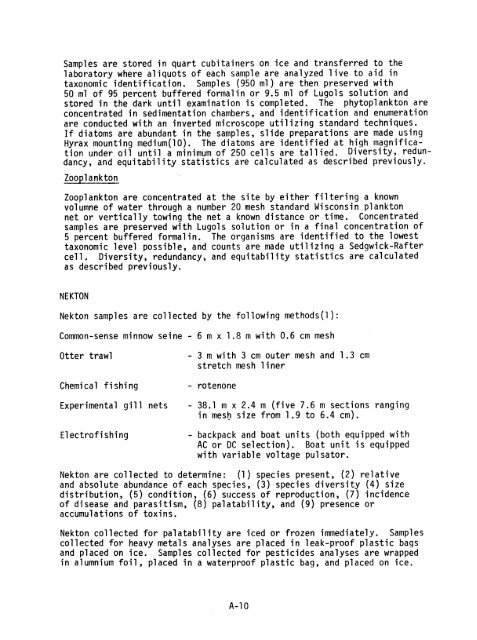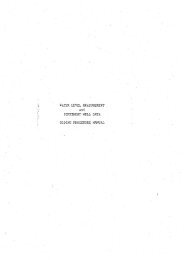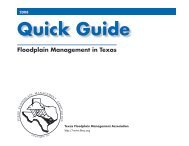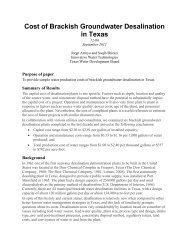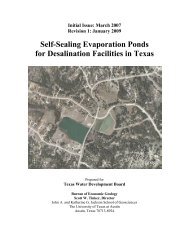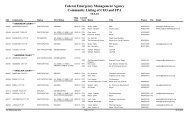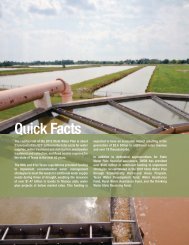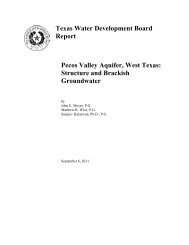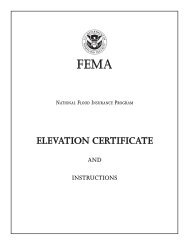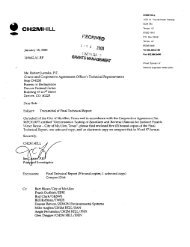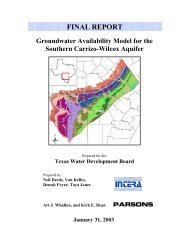Intensive Survey of the Guadalupe River Segment 1806
Intensive Survey of the Guadalupe River Segment 1806
Intensive Survey of the Guadalupe River Segment 1806
You also want an ePaper? Increase the reach of your titles
YUMPU automatically turns print PDFs into web optimized ePapers that Google loves.
Samples are stored in quart cubitainers on ice and transferred to <strong>the</strong><br />
laboratory where aliquots <strong>of</strong> each sample are analyzed live to aid in<br />
taxonomic identification. Samples (950 ml) are <strong>the</strong>n preserved with<br />
50 ml <strong>of</strong> 95 percent buffered formalin or 9.5 ml <strong>of</strong> Lugols solution and<br />
stored in <strong>the</strong> dark until examination is completed. The phytoplankton are<br />
concentrated in sedimentation chambers, and identification and enumeration<br />
are conducted with an inverted microscope utilizing standard techniques.<br />
If diatoms are abundant in <strong>the</strong> samples, slide preparations are made using<br />
Hyrax mounting medium(lO). The diatoms are identified at high magnifica<br />
tion under oil until a minimum <strong>of</strong> 250 cells are tallied. Diversity, redun<br />
dancy, and equitability statistics are calculated as described previously.<br />
Zooplankton<br />
Zooplankton are concentrated at <strong>the</strong> site by ei<strong>the</strong>r filtering a known<br />
volumne <strong>of</strong> water through a number 20 mesh standard Wisconsin plankton<br />
net or vertically towing <strong>the</strong> net a known distance or time. Concentrated<br />
samples are preserved with Lugols solution or in a final concentration <strong>of</strong><br />
5 percent buffered formalin. The organisms are identified to <strong>the</strong> lowest<br />
taxonomic level possible, and counts are made utilizing a Sedgwick-Rafter<br />
cell. Diversity, redundancy, and equitability statistics are calculated<br />
as described previously.<br />
NEKTON<br />
Nekton samples are collected by <strong>the</strong> following methods(l):<br />
Common-sense minnow seine - 6 m x 1.8 m with 0.6 cm mesh<br />
Otter trawl - 3 m with 3 cm outer mesh and 1.3 cm<br />
stretch mesh liner<br />
Chemical fishing - rotenone<br />
Experimental gill nets - 38.1 m x 2.4 m (five 7.6 m sections ranging<br />
in mesh size from 1.9 to 6.4 cm).<br />
Electr<strong>of</strong>ishing - backpack and boat units (both equipped with<br />
AC or DC selection). Boat unit is equipped<br />
with variable voltage pulsator.<br />
Nekton are collected to determine: (1) species present, (2) relative<br />
and absolute abundance <strong>of</strong> each species, (3) species diversity (4) size<br />
distribution, (5) condition, (6) success <strong>of</strong> reproduction, (7) incidence<br />
<strong>of</strong> disease and parasitism, (8) palatability, and (9) presence or<br />
accumulations <strong>of</strong> toxins.<br />
Nekton collected for palatability are iced or frozen immediately. Samples<br />
collected for heavy metals analyses are placed in leak-pro<strong>of</strong> plastic bags<br />
and placed on ice. Samples collected for pesticides analyses are wrapped<br />
in alumnium foil, placed in a waterpro<strong>of</strong> plastic bag, and placed on ice.<br />
A-10


